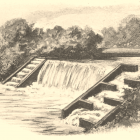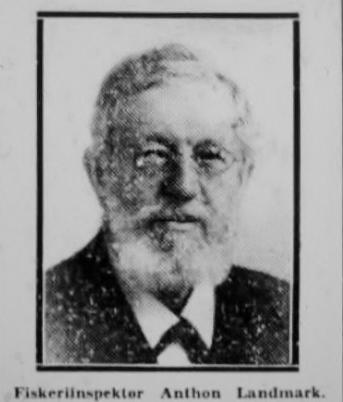
Portrait from an obituary for Anthon Landmark (1842–1932), the government inspector of fisheries from Norway.
Portrait from an obituary for Anthon Landmark (1842–1932), the government inspector of fisheries from Norway.
Unknown photographer, n.d.
Originally published in Aftenposten, 29 January 1932.
 This work is licensed under a Creative Commons Public Domain Mark 1.0 License.
This work is licensed under a Creative Commons Public Domain Mark 1.0 License.
At the turn of the twentieth century, attempts to dam rivers to produce vast amounts of energy presented a major challenge to maintaining riverine fisheries. In 1905, the German hydraulic engineer Johannes Oeltjen turned for assistance to Anthon Landmark, an internationally renowned expert on fisheries from Norway. Oeltjen asked Landmark to help with the introduction of a technology that had so far been unsuccessful along German watercourses: a fishway to assist salmon, trout, and eels to pass a newly designed dam that threatened to block their migration to spawning grounds. The dam was located on the Weser River in northern Germany near the small city of Hemelingen. Its double purpose was to produce hydroelectricity and regulate the water level for navigation.
As a hydraulic engineer, Oeltjen was experienced in the taming of natural forces and the transformation of rivers into “organic machines,” as historian Richard White phrased it. Technical means for the protection of fish, however, lay outside his field of expertise. For this reason, he contacted the fishery inspector Landmark, whose “salmon ladders” were internationally recognized. Oeltjen traveled to Norway and Sweden in 1907, where Landmark demonstrated various fishway designs. Shortly thereafter, Landmark paid a visit to Germany to bring his knowledge about fish behavior to the construction site on the Weser.
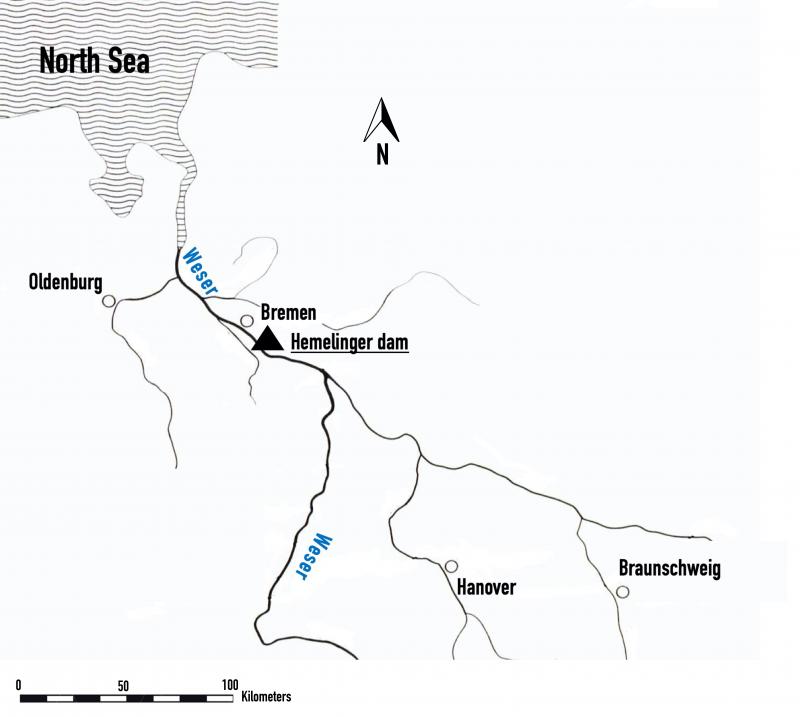
The map indicates the location of the fishway system at the Hemelinger Dam in northern Germany
The map indicates the location of the fishway system at the Hemelinger Dam in northern Germany
Map by Christian Zumbrägel, 2020.
 This work is licensed under a Creative Commons Attribution 4.0 International License.
This work is licensed under a Creative Commons Attribution 4.0 International License.
Fishways had been around for nearly two hundred years when Oeltjen and Landmark set about the task of enabling fish migration past the Hemelinger dam. They are mentioned in early modern legal proceedings, and the technology experienced a breakthrough during early industrialization. Well into the twentieth century, the most common type was the “fish ladder”—a series of steep steps or basins over which water flowed down the dam. As German textbooks and academic journals noted, such ladders were often “flawed” and “inefficient,” and rarely used by migrating fish.
On most streams in North America and Europe, fishways entered the discussion of fish protection after industrial and hydroelectric development had already interfered with or destroyed large populations of migrating fish. A pervasive reluctance to restrict economic activity undermined most efforts to develop effective fish passage facilities.
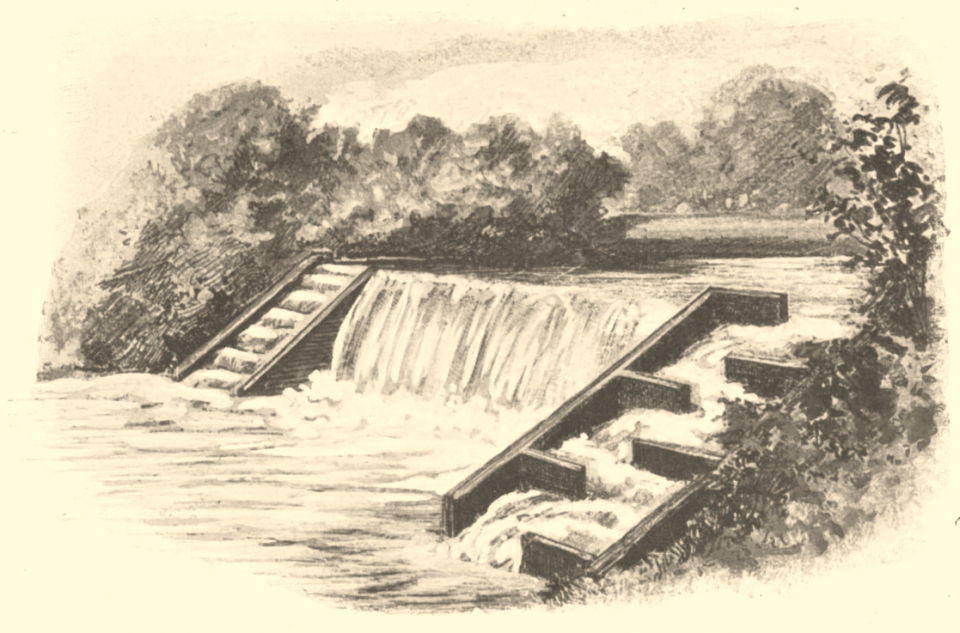
“Simple fish ladders” were widespread along German watercourses around 1900.
“Simple fish ladders” were widespread along German watercourses around 1900.
Unknown artist, n.d.
Originally published in Marianne Plehn, Die Fische des Meeres und der Binnengewässer, Eßlingen/München, 1906: 66-67.
 This work is licensed under a Creative Commons Public Domain Mark 1.0 License.
This work is licensed under a Creative Commons Public Domain Mark 1.0 License.
In contrast, fishways on the lower Weser originated in a different atmosphere. At this important fishery site, local fishing advocates had a powerful voice and forced the dam operators to create an effective fishway system.
The fish passage facilities took into account the migratory nature of different species. In the middle of the dam, a steep fish ladder made the climb possible for strong-swimming salmon, while a fish lock served species that were less capable of climbing. The dam also incorporated an eel pass for migrating juvenile eels. On the left bank of the Weser, meanwhile, a bypass channel (Wildpass in German) was built to convey adult salmon, trout, and shad from the North Sea to the upper course of the Weser River.

The hydroengineering facilities of the Hemelinger dam, including the fishway system.
The hydroengineering facilities of the Hemelinger dam, including the fishway system.
Unknown creator, 1920. Modified by Christian Zumbrägel, 2020.
Originally published in Hermann Henking, “Neue Wanderwege für die Fische der Unterweser,” Mittheilungen des deutschen Seefischereivereins 36 (1920): 112–122.
 This work is licensed under a Creative Commons Public Domain Mark 1.0 License.
This work is licensed under a Creative Commons Public Domain Mark 1.0 License.
Trained as a lawyer, the Norwegian fishery inspector Landmark had gained his knowledge about the migrating nature of travelling fish through self-education and observations he had made along rivers in Norway over many years. In his experience, even strong-swimming salmon, which were also capable of jumping, preferred swimming through flat and bright fishways. Therefore, he recommended conducting the fish around the Hemelinger dam in a dedicated flat bypass channel with extensive and well-lit basins, which the fish were able to surmount without great effort. While such a design was common in Scandinavia, it was uncommon in Germany. Local newspapers spoke of a fishway “of Norwegian design.”
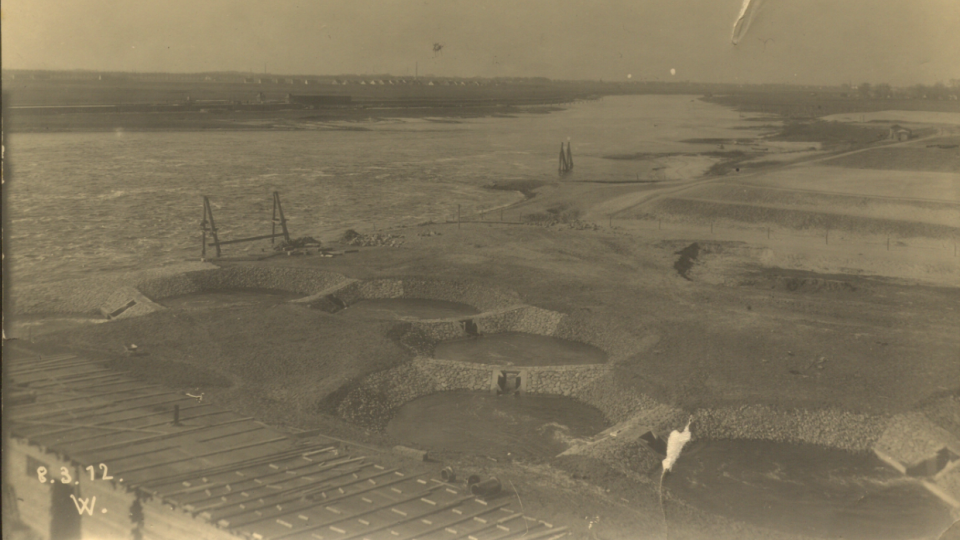
The bypass channel (Wildpass) at the Hemelinger Dam with its extensive and light-filled basins—a design that bears Landmark’s signature.
The bypass channel (Wildpass) at the Hemelinger Dam with its extensive and light-filled basins—a design that bears Landmark’s signature.
Unknown photographer, 1911.
Courtesy of State Archives Bremen [10, B-AL-1520].
Used by permission.
The copyright holder reserves, or holds for their own use, all the rights provided by copyright law, such as distribution, performance, and creation of derivative works.
Some other characteristics bore Landmark’s signature. On a compact and steep ladder, the fish required a lot of time to pass through it, and expended a great deal of energy swimming against the rapidly flowing water. If the current was too strong, Landmark attested, the fish would turn back or reach the headwater completely “groggy,” such that “fish robbers” like herons and otters would find an “abundantly laid table.” For this reason, he advised, the Wildpass should contain resting places. Near the shores of the basins the current was low, and the embankments were full of rushes offering shelter.
Various sources indicate that the Wildpass served its purposes. The dam- and lockkeeper registered lots of fish passing through the construction day by day. However, this does not mean that migrating fish interacted with the technology quite as expected. The photo below shows hundreds of small graylings and vimba in the first chamber—species that Oeltjen and Landmark didn’t have in mind while planning and implementing the fishway.
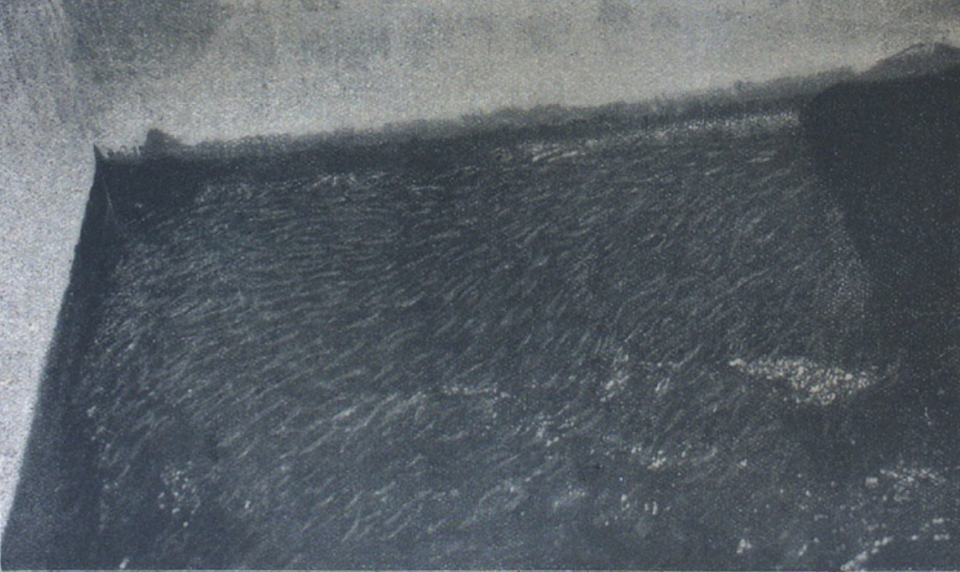
Hundreds of small fish crowded into the first chamber of the Wildpass.
Hundreds of small fish crowded into the first chamber of the Wildpass.
Unknown photographer, 1920.
Originally published in Hermann Henking, “Neue Wanderwege für die Fische der Unterweser,” Mittheilungen des deutschen Seefischereivereins 36 (1920): 112–122.
 This work is licensed under a Creative Commons Public Domain Mark 1.0 License.
This work is licensed under a Creative Commons Public Domain Mark 1.0 License.
After all, the Wildpass was designed solely to facilitate upstream migration of the economically important adult salmon, sturgeon, and trout. Sturgeon were never spotted, though, and many salmon also spurned the technology. Instead, most salmon preferred to reach the headwaters through the navigation lock. In a low-traffic night in 1954, the lockkeeper opened the navigation lock 29 times in a row—not for ships, but to let through adult salmon.
Migratory fish costructured and challenged the activities of Oeltjen and Landmark. Different fish respond differently to fishways, making it difficult to design a solution that works optimally in every situation. Know-how in hydraulic engineering, and Landmark’s practical experience obtained from observing salmon along Norwegian watercourses, were particularly important for the adaption of the technology to site-specific ecological conditions at the lower Weser River.
How to cite
Zumbrägel, Christian. “How a Fishway from Norway Reached the Weser River in Germany (1905–1912).” Environment & Society Portal, Arcadia (Summer 2020), no. 23. Rachel Carson Center for Environment and Society. https://doi.org/10.5282/rcc/9052.
ISSN 2199-3408
Environment & Society Portal, Arcadia
 This work is licensed under a Creative Commons Attribution 4.0 International License.
This work is licensed under a Creative Commons Attribution 4.0 International License.
2020 Christian Zumbrägel
This refers only to the text and does not include any image rights.
Please click on the images to view their individual rights status.
- Evenden, Matthew. Fish versus Power: An Environmental History of the Fraser River. Cambridge: Cambridge University Press, 2004.
- White, Richard. The Organic Machine: The Remaking of the Columbia River. New York: Hill and Wang. 1995.
- Zumbrägel, Christian. “Neue Technik auf alten Pfaden – Alte Fischschleusen als Leittechniken moderner Fischliftsysteme” [New technologies on old trails – Tracing the origins of modern fish lift systems]. WasserWirtschaft 109, no. 2–3 (2019): 47–52.
- McCully, Patrick. Silenced Rivers: The Ecology and Politics of Large Dams. London: Zed Books, 1996.
- Henking, Hermann. “Neue Wanderwege für die Fische der Unterweser” [New pathways for fish at Unterweser]. Mittheilungen des deutschen Seefischereivereins 36 (1920): 112–22.
- Landmark, Anthon. “Om Fiskvägar eller Laxtrappor” [Über Fischwege oder Lachstreppen]. In Svensk Fiskeri Tidskrift 13 (1904): 18–27.
- State Archives Bremen, Waterway Administration, 84: Dams, Fishway System.



